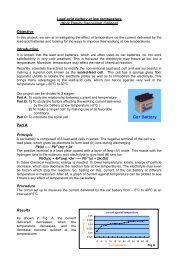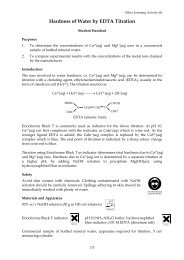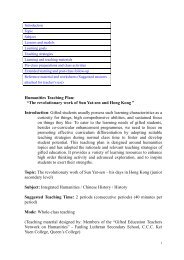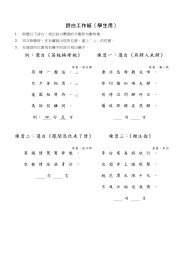Acid-base Titration using Method of Double Indicators
Acid-base Titration using Method of Double Indicators
Acid-base Titration using Method of Double Indicators
Create successful ePaper yourself
Turn your PDF publications into a flip-book with our unique Google optimized e-Paper software.
Datalogging Experiment (4)<strong>Acid</strong>-<strong>base</strong> <strong>Titration</strong> <strong>using</strong> <strong>Method</strong> <strong>of</strong> <strong>Double</strong> <strong>Indicators</strong>Student HandoutPurposesTo determine the composition <strong>of</strong> the following mixture by double indicator method:1. NaOH(aq) and Na 2 CO 3 (aq)2. NaHCO 3 (aq) and Na 2 CO 3 (aq)IntroductionConsider a mixture <strong>of</strong> NaOH(aq) and Na 2 CO 3 (aq) . Reaction between HCl(aq) andNa 2 CO 3 (aq) takes place in two stages:HCl(aq) + Na 2 CO 3 (aq) ⎯→ NaHCO 3 (aq) + H 2 O(l) …………………. (1)HCl(aq) + NaHCO 3 (aq) ⎯→ NaCl(aq) + CO 2 (g) + H 2 O(l) …………. (2)While that between HCl(aq) and NaOH(aq) completes in only one step:HCl(aq) + NaOH(aq) ⎯→ NaCl(aq) + H 2 O(l) ……………….………. (3)Solution mixture <strong>of</strong> reaction (1) at the equivalence point is alkaline, that <strong>of</strong> reaction (2) isacidic and that <strong>of</strong> reaction (3) is neutral. Thus the whole titration should have threebreaks in the pH curve, corresponding to the above three stages. Reactions (1) and (3)can be indicated by phenolphthalein and that <strong>of</strong> reaction (2) can be indicated by methylorange.Stoichiometry confines each <strong>of</strong> the abovereactions to react according to a mole ratio<strong>of</strong> 1 : 1. This means, say from equation (2),the number <strong>of</strong> mole <strong>of</strong> HCl(aq) determinedfrom the methyl orange titration is equal tothe number <strong>of</strong> mole <strong>of</strong> NaHCO 3 (aq).Likewise, total number <strong>of</strong> moles <strong>of</strong>NaOH(aq) and Na 2 CO 3 (aq) in the solutionmixture can be calculated according to thevolumes <strong>of</strong> HCl(aq) added at the end pointindicated by the colour change <strong>of</strong> thephenolphthalein indicator. Alternatively, thethree break points (see Fig. 1) also indicatethe volume <strong>of</strong> HCl(aq) required for eachreaction.pHVol. <strong>of</strong> HClFig. 1: <strong>Titration</strong> curve for a mixture <strong>of</strong>NaOH(aq) and Na 2 CO 3 (aq) with HCl(aq)49
Datalogging Experiment (4)For the titration <strong>of</strong> a mixture <strong>of</strong> NaHCO 3 (aq)and Na 2 CO 3 (aq) with HCl(aq), only twobreak points are expected (see Fig.2).Volume <strong>of</strong> HCl(aq) added for each breakpoint can be easily obtained by observingeither the colour change at the end point orthe shape <strong>of</strong> the titration curve.pHVol <strong>of</strong> HClFig. 2: <strong>Titration</strong> curve for a mixture <strong>of</strong>NaHCO 3 (aq) and Na 2 CO 3 (aq) with HCl(aq)SafetyAvoid skin contact with chemicals. Any acid or alkali spilt should bethoroughly washed with tap water.Materials and ApparatusEYE PROTECTIONMUST BE WORNPhenolphthalein indicator, methyl orange indicatorFLAMMABLEStandard 0.15 M and 0.2 M HCl(aq), a mixture <strong>of</strong> NaOH(aq) and Na 2 CO 3 (aq), a mixture <strong>of</strong>NaHCO 3 (aq) and Na 2 CO 3 (aq), deionised water, a datalogger with pH sensor, computer,magnetic stirrer, small beaker, burette and pipette, stand and burette clamp.Experimental ProceduresPart A: <strong>Titration</strong> <strong>of</strong> a mixture <strong>of</strong> NaOH(aq) and Na 2 CO 3 (aq) with 0.15 M HCl(aq) <strong>using</strong>phenolphthalein indicator followed by methyl orange indicator1. Set up the interface box and connect it to the computer. Arrange the setup for pHdetermination. The pH sensor should be calibrated before use.2. Pipette 25 cm 3 <strong>of</strong> the solution mixture into a small beaker and add 2 drops <strong>of</strong>phenolphthalein indicator. Place a stirrer bar into the alkaline solution and restthe beaker on a magnetic stirrer which is covered by a white tile. Switch on themagnetic stirrer. Lower the pH electrode into the alkaline solution, ensuring thatthe glass bulb is completely immersed while the stirrer bar is spinning smoothly(see Fig. 3).Fig. 3: Setup for pH datalogging50
Datalogging Experiment (4)3. Start the datalogging s<strong>of</strong>tware and select the pH sensor with graph display screenformat. Set the pH value limits from 0 to 13. The logging mode is set to manualoperation with readings taken for each cm 3 addition <strong>of</strong> the titrant.4. Fill the burette with 0.15 M HCl(aq). Turn the stopcock <strong>of</strong> the burette open andstart recording at the same time. When approaching the first end point, as judgedby the rate <strong>of</strong> disappearance <strong>of</strong> the red colour <strong>of</strong> the solution in the beaker, adjustinterval additions each to 0.50 cm 3 . Allow time for the evolution <strong>of</strong> CO 2 gasbubbles as their presence round the glass bulb <strong>of</strong> the electrode may interfere withpH measurements.5. Observe the colour change <strong>of</strong> the reaction mixture and the pH values displayedon the computer screen carefully when the titration passes the first end point.6. Add 3 drops <strong>of</strong> methyl orange indicator when the reaction mixture becomescolourless. Look for the second end point and continue titration as in step (4) untila total volume <strong>of</strong> 50 cm 3 <strong>of</strong> the titrant has been added.7. Save the data file.8. Carefully empty the contents <strong>of</strong> the beaker, pay special attention to retain thesmall stirrer bar. Clean the pH electrode with deionised water.Part B9. As described above, titrate a mixture <strong>of</strong> NaHCO 3 (aq) and Na 2 CO 3 (aq) with 0.20 MHCl(aq) <strong>using</strong> phenolphthalein indicator followed by methyl orange indicator.ResultsTable AFinal burette reading/cm 3Initial burette reading/cm 3Volume <strong>of</strong> 0.15 M HCl used/cm 3PhenolphthaleinindicatorMethyl orangeindicatorTable BFinal burette reading/cm 3Initial burette reading/cm 3Volume <strong>of</strong> 0.20 M HCl used/cm 3PhenolphthaleinindicatorMethyl orangeindicator51
Datalogging Experiment (4)Treatment <strong>of</strong> DataPart A1. From the methyl orange end point, calculate the number <strong>of</strong> moles <strong>of</strong> 0.15 M HCl(aq)added and hence the number <strong>of</strong> moles <strong>of</strong> Na 2 CO 3 (aq) in 25 cm 3 <strong>of</strong> the alkalinesolution mixture.2. From the phenolphthalein end point, calculate the number <strong>of</strong> moles <strong>of</strong> 0.15 MHCl(aq) added and hence the total number <strong>of</strong> moles <strong>of</strong> NaOH(aq) and Na 2 CO 3 (aq)in 25 cm 3 <strong>of</strong> the solution mixture.3. Calculate the number <strong>of</strong> mole <strong>of</strong> NaOH(aq) in 25 cm 3 <strong>of</strong> the solution mixture.4. Calculate the mass <strong>of</strong> Na 2 CO 3 and NaOH in 1 dm 3 <strong>of</strong> the solution mixturerespectively.Part B1. From the methyl orange end point, calculate the number <strong>of</strong> moles <strong>of</strong> 0.2 M HCl(aq)added and hence the number <strong>of</strong> moles <strong>of</strong> Na 2 CO 3 (aq) in 25 cm 3 <strong>of</strong> the solutionmixture.2. From the phenolphthalein end point, calculate the number <strong>of</strong> moles <strong>of</strong> 0.2 MHCl(aq) added and hence the number <strong>of</strong> moles <strong>of</strong> NaHCO 3 (aq) in 25 cm 3 <strong>of</strong> thesolution mixture.3. Calculate the mass <strong>of</strong> Na 2 CO 3 and that <strong>of</strong> NaHCO 3 in 1 dm 3 <strong>of</strong> the solution mixture.Discussion Questions1. Suggest other indicators that can be used in place <strong>of</strong> methyl orange andphenolphthalein. Explain.2. Can the same method be applied to determine the concentrations <strong>of</strong> Na 3 PO 4 (aq)and NaH 2 PO 4 (aq) in a solution mixture <strong>of</strong> the two salts? What factors should beconsidered?52
















